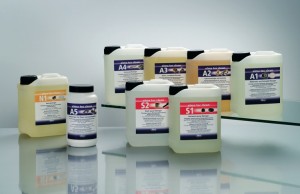Ultrasonic Cleaner Hints
You know the routine. Chances are you’ve done it yourself. If the recipe calls for a tablespoon of oregano you think well, two tablespoons will make it taste better. If directions say bake at 325⁰F you think well, if I bake at 425⁰F it will be done faster. That’s not the always the case for recipes and it certainly is not the case when you operate an ultrasonic cleaner.
How to Prepare Ultrasonic Cleaning Solution from Concentrate
This is the recipe portion of our introductory paragraph. Ultrasonic cleaning solution concentrates are formulated to be diluted with a specific amount of water. An example is the widely used general purpose elma tec A4 concentrate where the recommendation is dilution to 2% – 5% with water.
Now on the often mistaken theory of “more is better” you may be tempted to dump in a little more concentrate. Perhaps a little more won’t hurt other than waste product. But think about this: if your laundry detergent calls for a quarter cup per load and you dump in a full cup you’ll probably have bubbles all over the laundry room floor and a very unsatisfactory cleaning result to boot.
Tovatech tip: Follow instructions in preparing the cleaning bath.
If you’ve mixed the cleaning solution correctly and the ultrasonic cleaner is not cleaning there may be another cause. Did you degas the solution? Is the concentrate formulation matched to the contaminants being removed? If you notice a drop-off in cleaning efficiency chances are the solution has absorbed a full load of contaminants and it is time to be replaced. For tips on maintaining ultrasonic cleaning solutions see our post on skimmers and filters.
Assume a worst-case situation: a multi-gallon industrial-sized cleaning bath that isn’t doing the job. After you’ve checked off the above suggestions you can conduct concentration tests by contacting the experts at Tovatech for recommendations. In this instance corrective measures usually but not always involve adding more water or more concentrate.
How Hot is Hot in Ultrasonic Cleaning?
Heat is a natural result when operating an ultrasonic cleaner and in most instances heat is desirable to remove grease and other oily contaminants. Main exceptions are cleaning used medical and surgical instruments, and cleaning with volatile solvents. With the exception of explosion-proof models large capacity industrial ultrasonic cleaners have built-in heaters and thermostats.
Higher temperatures usually result in more efficient cleaning but only up to a point. Above 80⁰C (176⁰F) cleaning efficiency drops off and all you do is waste electricity. Going back to our elma tec clean A4 example the cleaning temperature recommended is 50⁰ to 80⁰C.
And to our recipe, upping the oven temperature to 425⁰F vs. the recommended 325⁰F will probably ruin the roast.
High temperatures can damage products such as printed circuit boards. Solutions that are too hot can also cause less delicate products to flash dry too quickly. This can result in deposition of hard-to-remove cleaning solution residue or rust before parts are rinsed.
In some instances overheating will cause surfactants in the cleaning solution to “demulsify.” In this case they separate and rise to the top of the solution and may appear as an oily sheen that can be mistaken as contaminants. Unlike a permanently spoiled burned roast, in these instances the fix is reducing heat and attempting to remix the solution.
Tovatech tip: Follow instructions in setting cleaning solution temperature.
To conclude, selecting the correct ultrasonic cleaning solution concentrate, diluting it to the recommended concentration and using it at the recommended temperature are three keys to success in operating industrial ultrasonic cleaners. The experts at Tovatech are ready to help you solve your cleaning challenges.

